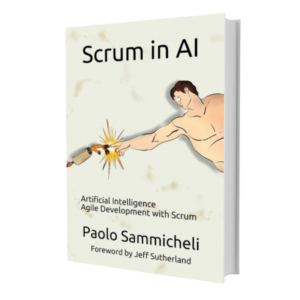For Italy’s Agile Community, an Era of Scrum in AI is on the Horizon. And Scrum Trainer Paolo Sammicheli is Breaking Ground.
Paolo Sammicheli is a Scrum Trainer, Scrum@Scale Trainer, and passionate Agile business coach. Paolo resides in the heart of Tuscany, Italy, and has an impressive track record of successfully helping international companies uncover better ways of building products. In Paolo’s words, he is “a computer scientist first, and an Agile coach and trainer second.” Like many in his position, Paolo started his career in roles such as Project Manager and Software Architect. Eventually, however, Paolo’s innate desire to help others emerged. Within just a few years of learning about Scrum and Agile, Paolo started his journey in coaching, training, and developing high-performing teams.
business coach. Paolo resides in the heart of Tuscany, Italy, and has an impressive track record of successfully helping international companies uncover better ways of building products. In Paolo’s words, he is “a computer scientist first, and an Agile coach and trainer second.” Like many in his position, Paolo started his career in roles such as Project Manager and Software Architect. Eventually, however, Paolo’s innate desire to help others emerged. Within just a few years of learning about Scrum and Agile, Paolo started his journey in coaching, training, and developing high-performing teams.
Paolo’s Italian roots and dedication to continuous improvement are the first things you notice about him. During the 2020 COVID-19 pandemic, it was not uncommon for Paolo to join the Scrum@Scale Trainer happy hour sessions from his kitchen, while cooking dinner and enjoying an ice cream cone. Paolo joins every conversation with a contagious enthusiasm; within seconds his passion for learning and evolution emerge. If there is room for improvement, Paolo has taken advantage of it. He continuously seeks (and implements) feedback and encourages his students to do the same. In a recent Agile Education post-course review, one of Paolo’s students explained, “Paolo is a great teacher, his knowledge is huge. His style is fascinating. He challenges his class and pushes them forward. His teaching is greatly effective.”
Paolo’s passion and desire to expand his knowledge led him to publish his first book, Scrum for Hardware. led him to publish his second book, Scrum in AI which includes a forward from Dr. Jeff Sutherland, co-creator of Scrum and creator of Scrum@Scale.
In Scrum in AI, Paolo invites readers to discover how to develop Artificial Intelligence (AI) based applications with Agile and Scrum. In true Agile fashion, Paolo claims, “I don’t consider myself an expert at all on the topic of Artificial Intelligence. I am writing this book because I decided to put it in order and publish all the notes and the learnings I am having in this never-ending journey.” Paolo’s focus has always been and will always be on this concept of a “never-ending journey.” His history proves that Paolo is a true Agilist at heart; someone who embodies the Scrum values, who always seeks to better himself and others, and who just happens to be building innovative, life-changing products along the way.
By publishing Scrum in AI, Paolo is starting a conversation in the Agile community about what it means to iteratively build a new frontier. Paolo notes, “The book is written iteratively, following the Agile approach. In this way, I hope to bring the best I know about the subject to the public in the shortest time and receive feedback to create the best book on how to develop an AI-based application with Agile.”
An Interview with Paolo Sammicheli.
AEP: What led you to Artificial Intelligence? And, more importantly, what sparked your interest in AI?
Paolo: About three years ago, a former employee of GoogleX, the AI division of Google, contacted me on Linkedin. He was spending his holidays in Tuscany and asked me if I could organize an event with my Agile Lean Tuscany meetup. We met one of the following evenings for a beer, and I extended the invitation to other geeks to connect him with the local tech community. We talked the whole evening about Artificial Intelligence, not only from a technical point of view but also from an ethical and social perspective. This deep conversation ignited the desire to learn more, so I started reading books, papers and watching videos on Youtube. During the first lockdown, I took advantage of my home confinement to enroll at MIT Sloan and take a couple of online courses. One of them was about Artificial Intelligence. While I was deepening the topic, customers asked me to help some Teams developing machine learning with Scrum, and, in a short time, I found myself having more than half of my time coaching AI teams.
AEP: Tell us about the cover art. Does this mean you feel AI is approachable and inevitable?
Paolo: The reference to the Sistine Chapel, Michelangelo’s fresco of Adam’s Animation, for me, means that we are witnessing a historic moment comparable to the appearance of man on Earth. It will be something that will profoundly change our society. Whether for the better, or the worse, depends only on us. The artist who designed the cover is an old friend of mine, Fabio Colinelli. You can learn more about him in his interview on the Scrum-Ai Blog.
AEP: Publishing a book in an iterative fashion goes against traditional approaches to publishing. Usually, the book publication process is long and laborious. What benefits are there to the reader in this iterative approach?
Paolo: A topic like this cannot be written in the traditional way without publishing something already outdated. The speed at which we see progress is incompatible with a waterfall approach: write the whole book and then publish it all at once. The publication rate of relevant scientific papers is dozens per day! Even in my previous book, Scrum for Hardware, I saw an undeniable benefit: a lot of the most interesting material that is in the book was added when I had already published the first early version, because many people approached me saying, “I heard about your book, I have things to show you.” It’s a recursive effect: You find a lot more material for your book because you wrote a book. An additional aspect is my motivation for writing. I’m a geek, a technologist, not a writer. I couldn’t write a long text without solid motivational feedback. Writing at a sustainable pace allows you to write better, longer, balancing personal and work activities.
AEP: What’s next after AI?
Paolo: Putting Hardware and Artificial Intelligence together, I should have all the ingredients to finally fulfill my childhood dream and build a giant robot, like Gundam or Daitarn III. So maybe the next step could be to write Scrum for Superheroes. 😎
AEP: What key learnings from Scrum in Hardware have you applied to Scrum in AI?
Paolo: What you learn a lot from developing Hardware is the importance of agile product architecture and the effects of Conway’s law since you physically see the increment. Software architectures are invisible in practice. Many teams have a hard time visualizing the architecture, patterns, and choices made in the software product. I have used hardware architecture metaphors with AI Teams and have had very encouraging feedback. They found it helpful.
AEP: What is your advice to professionals who feel stuck or uninspired in their careers right now?
Paolo: One first piece of inspiration is the quote, “if you’re the smartest person in the room you’re in the wrong room.” Surround yourself with talented people as much as possible and turn off your ego. It doesn’t matter how much you know now. It matters how fast you are learning. A second one is from Pablo Picasso: “bad artists copy, great artists steal.” Surround yourself with great people and make pieces of their style yours. In this way, you’ll create your new and unique style.

